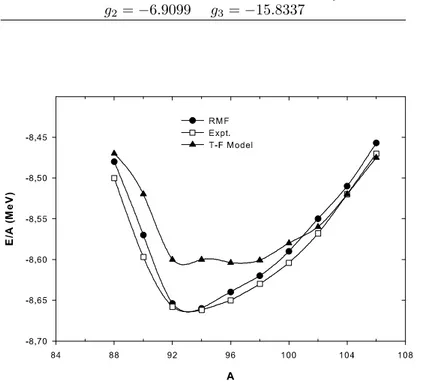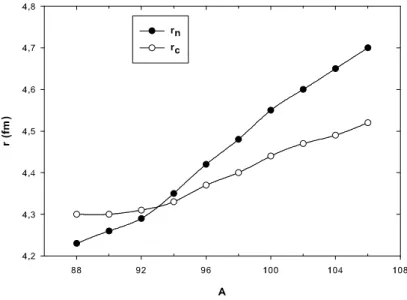c
° Bogazici University Press 10 February 2010
BPL, 18, 181015, pp. 118-125 (2010)
INVESTIGATION OF SOME EVEN-EVEN Mo NUCLEI IN RELATIVISTIC MEAN FIELD THEORY
T. BAYRAM, Z. ZENG˙IN, M. DEM˙IRC˙I and A. H. YILMAZ Physics Department, Karadeniz Technical University,
Trabzon, TURKEY
Abstract. - The structures of the nuclei on isotope chain of even-even Mo are investigated in the axially deformed relativistic mean-field theory with the NL-SH forces. We put an emphasis on the ground state properties of molybde-num nuclei. With high neutron molybde-number is correctly reproduced in the relativistic mean-field theory (RMF). In general, the RMF theory can give a good descrip-tion of the isotope chain of Mo nuclei.
PACS numbers
23.60.+e, 21.60.-n, 21.10.Dr Keywords
Relativistic mean field, even-even Mo nuclei, binding energy, deformations
One of the main aims of researches in nuclear physics is to try to describe ground-state properties of nuclei in the whole mass region. Unfortunately, due to lack of understanding in strong interaction and numerical difficulty in treating nuclear many-body problems, so far all microscopic descriptions are only possible on a phenomeno-logical ground. The relativistic mean field theory of the nucleus has been a fairly successful application of Dirac phenomenology. It has been applied to study the binding energy, the shape of the ground state and various other properties of nu-clei. An excellent recent review by Ring [1], gives a comprehensive list of references. Recent advances include studies in dripline regions through the relativistic Hartree-Bogoliubov formalism [2], explanation of pseudospin symmetry [3], etc.
nucle-ons are described as Dirac particles which interact via the exchange of various mesnucle-ons. The Lagrangian density considered is written in the form:
L = ¯ψ(i 6 ∂ − M )ψ +1 2∂µσ∂ µσ − U (σ) −1 4ΩµνΩ µν +1 2m 2 ωωµωµ−1 4R~µν R~ µν+1 2m 2 ρ~ρµ~ρµ− (1) 1 4FµνF µν− g σψσψ − g¯ ωψ 6 ωψ − g¯ ρψ 6 ρ~τψ − e ¯¯ ψ 6 Aψ
The meson fields included are the isoscalar σ-meson, the isoscalar-vector ω-meson and the isovector-vector ρ-meson. The latter provides the necessary isospin asymme-try. The arrows in Eq. (1) denote the isovector quantities. The Lagrangian contains also a non-linear scalar self-interaction of the σ-meson.
U (σ) = 1 2m 2 σσ2+ 1 3g2σ 3+1 4g3σ 4 (2)
This term is important for appropriate description of surface properties [7]. M, mσ,mωand mρ are the nucleon-, the σ-, the ω- and the ρ-meson masses respectively,
while gσ, gω, gρand e 2
4π =1371 are the corresponding coupling constants for the mesons and the photon. The field tensors of the vector mesons and of the electromagnetic fields take the following form:
Ωµν = ∂µων− ∂νωµ (3)
~
Rµν = ∂µ~ρν− ∂ν~ρµ (4)
Fµν = ∂µAν− ∂νAµ (5)
The variational principle gives the equations of motion. The mean field approxi-mation is introduced at this stage by treating the fields as the c-number or classical fields. This results into a set of coupled equations namely the Dirac equation with potential terms for the nucleons and the Klein-Gordon type equations with sources for the mesons and the photon. For the static case, along with the time reversal invari-ance and charge conservation the equations get simplified. The resulting equations, known as RMF equations have the following form.
Dirac equation for the nucleon,
{−iα 5 +V (r) + β [M + S(r)]}ψi= εiψi (6)
V (r) = gωω0(r) + gρτ3ρ0(r) + e1 + τ3
2 A0(r) (7)
and S(r) is the scalar potential:
S(r) = gσσ(r) (8)
the latter contributes to the effective mass as:
M∗= M + S(r) (9)
The Klein-Gordon equations for the meson and electromagnetic fields with the nucleon densities as sources:
{−∆ + m2σ}σ(r) = −gσρs(r) − g2σ2(r) − g3σ3(r) (10) {−∆ + m2 ω}ω0(r) = gωρν(r) (11) {−∆ + m2 ρ}ρ0(r) = gρρ3(r) (12) −∆A0(r) = eρc(r) (13)
The corresponding densities are:
ρs= A X i=1 niψ¯iψi (14) ρν= A X i=1 niψ†iψi (15) ρ3= Z X i=1 niψp†ψp− N X i=1 niψn†ψn (16) ρc = Z X p=1 niψp†ψp (17)
Here the sums are taken over the particle states only. This implies that the con-tributions from negative-energy states are neglected (no-sea approximation), i.e. the vacuum is not polarized. The π-meson does not contribute in the present relativistic mean field (Hartree) approximation because of its pseudo nature. The occupation number ni is introduced to account for pairing which is important for open shell
nu-clei. In the absence of pairing it takes the value one (zero) for the levels below (above) the Fermi surface. In the presence of pairing the partial occupancies (ni) are obtained
ni= 1 2(1 − εi− λ p (εi− λ)2+ ∆2 ) (18)
The εi is the single-particle energy for the state i and chemical potential or Fermi
energy λ for protons (neutrons) is obtained from the requirement X
i=1
ni= the number of protons(Z)
(the number of neutrons(N )) (19)
The sum is taken over protons (neutrons) states. The gap parameter ∆ is calcu-lated from the observed odd-even mass differences. In the absence of experimental masses it can inferred from the extrapolation of the masses given by any of the avalaible mass formulae.
The above set of equations (6,10,11,12 and 13) are to be solved self-consistently. For this purpose one starts with an initial guess of the fields (e.g. generated by axially deformed Woods-Saxon potential) to calculate the potential terms (Eqs. (7, 8)) appearing in the Dirac equation (Eq. (6)). The Dirac equation is solved with these potentials terms to yield the nucleon spinors which in term are used to obtain the sources (densities). The meson and photon equations are then solved with these sources to get a new set of fields to be used for the calculation of new potential terms. The Dirac equation is then solved with the new potentials to get the spinors again to be used to obtain the new sources for the meson fields. This iterative procedure is continued till the converegence upto the desired accuracy is achieved.
The total binding energy is written as
E = Epart+ Eσ+ Eω+ Eρ + ECoul+ Epair+ Enl− Ec.m− AM. (20)
DETAILS OF CALCULATIONS
The molybdenum nuclei considered here are even-mass nuclei with mass number A = 88 up to 106. All of these isotopes are open-shell nuclei both in protons and neutrons, thus requiring the inclusion of pairing. The parameter set NL-SH [8] has been employed for all nuclei. This set has been found to be very successful for the ground-state properties of many nuclei. The number of shells taken into account are 12 and 20 for the fermionic (NF) and bosonic (NB) expansion, respectively. The basis
parameters ¯hω and β0 used for the calculations have been taken to be 41A−1/3 and 0.0, respectively.
In order to investigate these Mo nuclei we have performed the calculations with Saxoon-Woods initial wavefunctions.
There are a number of parametrization sets for prediction of the nuclear ground state properties [1]. We used the parameter set NL-SH [8] in the present calculation.
Table 1: The parameters of the force NL-SH. All the masses are in MeV, while g2is in f m−1. The other coupling constants are dimensionless.
M = 939.0 mσ= 526.059 mω= 783.0 mρ= 763.0
gσ= 10.444 gω= 12.945 gρ= 4.383
g2= −6.9099 g3= −15.8337
Figure 1: The calculated binding energy per nucleon for Mo isotopes.
Fig.1 shows the binding energy per nucleon (E/A) for Mo isotopes. The empir-ical values which is from Thomas Fermi Model taken from [9] are also shown. The parabolic shapes of the binding energy per nucleon emerges nicely. The minimum in the binding energy is observed at the magic neutron number N = 50 in RMF theory. The calculated RMF binding energies agree very closely the experimental values [10]. We give in Fig.2 the quadrupole deformation β2for the shape correspondingto the lowest energy. It is seen that β2is close to zero in the ligher isotopes of molybdenum. This turns out that these nuclei are spherical near the magic neutron number N = 50. Nuclei above this magic number the shape turns to prolate one. In Fig.3 the r.m.s. charge and neutron radii of Mo nuclei are shown. It is seen that ongoing from the lighter isotopes to the heavier ones the charge radii exhibit a decreasing trend upto the magic isotope, that is the lighter isotopes have higher charge radii than the heavier closed neutron- shell nucleus. The charge radii for nuclei heavier than the closed neutron-shell start increasing with addition of neutrons. The neutron
Figure 2: The quadrupole deformation β2for Mo nuclei.
Table 2: Some calculated energy values of Mo isotopic chain obtained by using the force NL-SH.
E(M eV ) Eσ Eσnl Eω Eρ EC Epair Ecm Etotal
88M o -12493.1 -236.88 10526.7 2.59 281.84 -12.63 -6.91 -744.06 90M o -12897.9 -244.16 10869.5 5.02 281.53 -12.32 -6.86 -770.72 92M o -13289.6 -251.12 11201.18 8.26 281.09 -11.39 -6.81 -796.16 94M o -13489.6 -255.87 11365.02 11.79 279.68 -13.31 -6.76 -810.37 96M o -13763.9 -261.53 11591.1 16.13 277.50 -12.48 -6.72 -827.34 98M o -13969.7 -266.17 11759.3 20.87 275.99 -12.74 -6.67 -841.91 100M o -14256.3 -271.56 11995.9 26.39 274.19 -12.48 -6.62 -857.76 102M o -14536.5 -277.06 12225.7 32.57 272.82 -12.55 -6.58 -871.25 104M o -14783.2 -282.20 12427.8 39.15 271.52 -12.75 -6.54 -884.11 106M o -15017.09 -287.07 12619.2 46.06 270.18 -12.82 -6.49 -896.49
Table 3: The calculated quadrupole values of Mo nuclei.
Qn(b) Qp(b) Q(b) 88M o 0.18 0.15 0.33 90M o 0.032 0.031 0.063 92M o 0.011 0.013 0.02 94M o 0.032 0.027 0.059 96M o 2.022 1.597 3.619 98M o 2.467 1.775 4.242 100M o 3.761 2.665 6.425 102M o 4.577 3.051 7.628 104M o 5.009 3.212 8.221 106M o 5.559 3.477 9.036
radii, on the other hand, also show a kink about the neutron shell closure. However, the neutron radius for lighter isotopes in these chains is not higher than that of the closed-shell nucleus.
In Table 2 we present some calculated energy values of molybdenum nuclei. It is also given calculated quadrupole moments of neutron and proton in Mo isotopes in Table 3.
SUMMARY
The relativistic mean field theory has been used to study a number of Mo isotopes in the mass 88-106 region. The ground state properties of these nuclei have been calculated using rmfaxial code [11]. It is found out that the rmf theory is capable of describing Mo nuclei.
REFERENCES
[1] P.Ring, Prog.Part.Nucl.Phys. 37 , 193 (1996)
[2] P. Ring and P. Schuck, The Nuclear Many-Body Problem. Springer-Verlag , Berlin (1980)
[3] J.N.Ginocchio,Phys.Rev.Lett. 78 , 436 (1997)
[4] B.D. Serot and J.D. Walecka, Adv. Nucl. Phys. 16, 1 (1986). [5] B.D. Serot, Rep. Prog. Phys. 55, 1855 (1992).
[6] M.M. Sharma, G.A. Lalazissis, and P. Ring, Phys. Lett. B317, 9 (1993). [7] J. Boguta and A.R. Bodmer,Nucl. Phys. A292,413 (1977)
[8] M.M.Sharma and M.A.Nagarajan, Phys.Lett. B312, 377 (1993) [9] W.D. Myers and W.J. Swiatecki, http:// nsdssd.lbl.gov
[10] G. Audi and A.H. Wapstra, Nucl. Phys. A565, 1 (1993)


